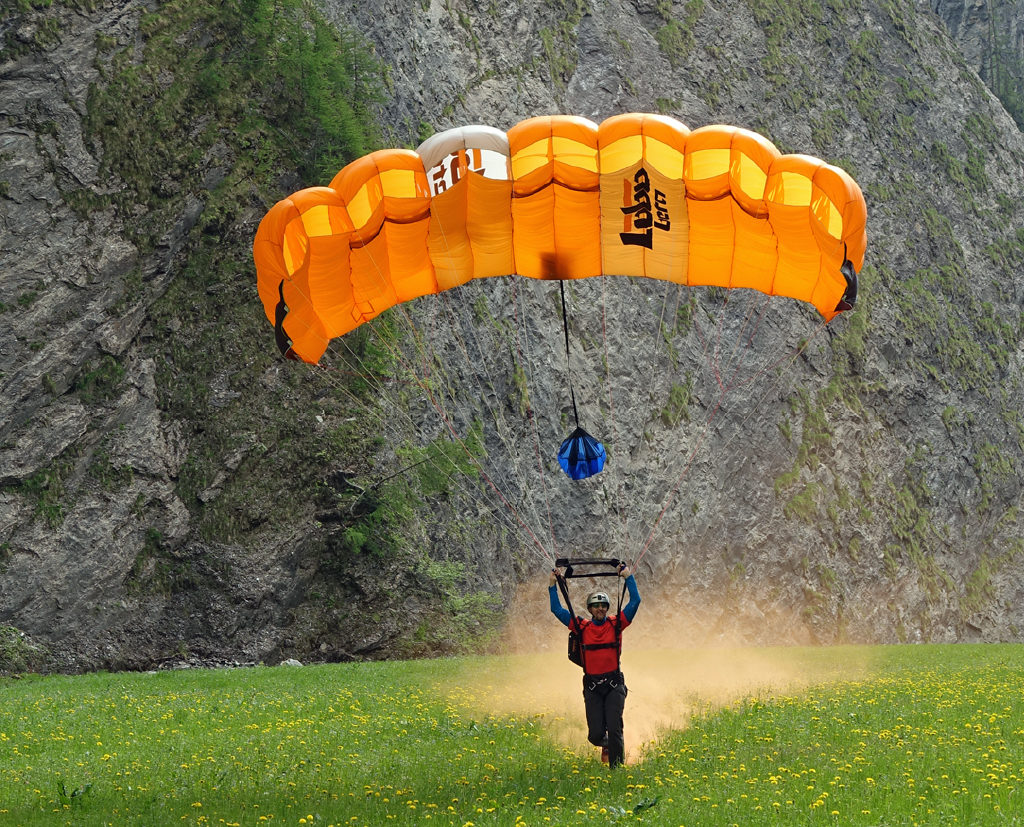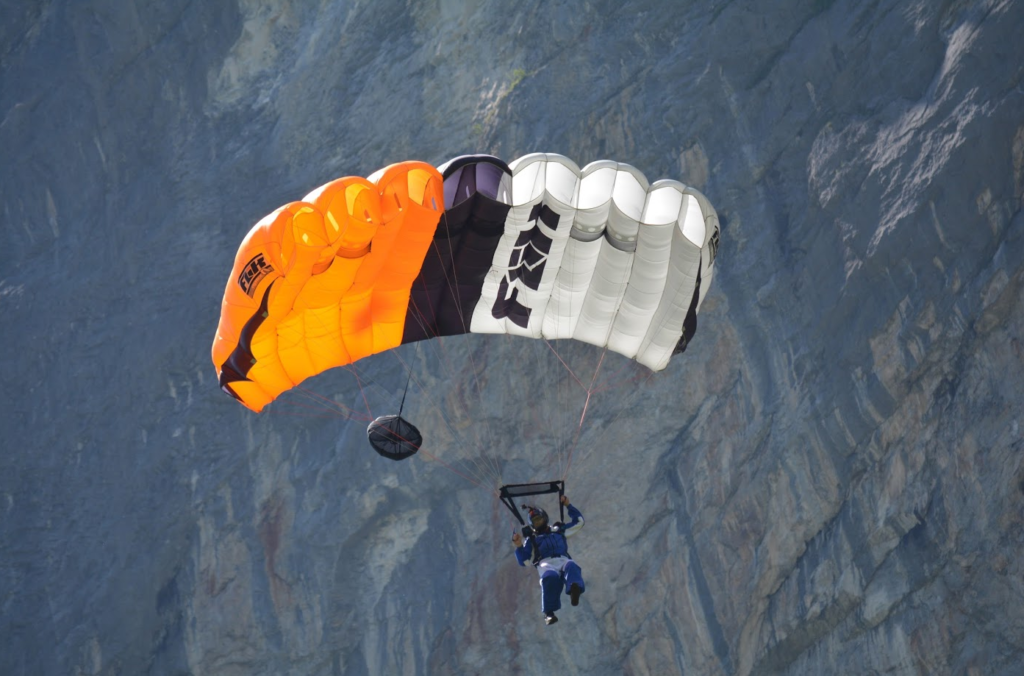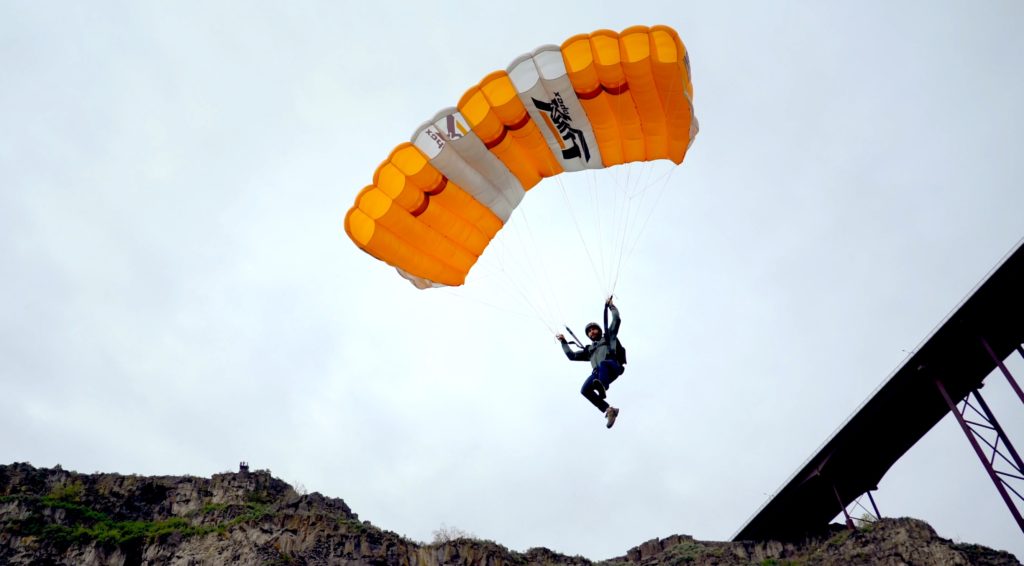What size BASE canopy do I need?
Skydivers have a tendency to associate higher wing loading and smaller parachutes with pilot skill and proficiency. It has been baked into our learning progressions and DZ cultures. You buy a canopy, you get comfortable with it, and then you downsize.
Skydiving is not BASE jumping, and we treat canopy progression and wing loading very differently.
In BASE jumping wing loading is not typically correlated with experience and/or skill. An acceptable range of wing loadings has been established with different hazards coming into play as you get too far beyond that range on either side. In short, you should load your BASE canopy at (expressed in pounds per square foot):
.625 – .725
To calculate wing loading take your weight (in pounds) and divide it by canopy size. At Apex BASE we prefer to use body weight (without gear) as it provides the most consistent numerator.
For example: 180 lbs. / 260 square foot canopy = .69 lbs./sq. ft.
In skydiving we add gear weight because it is significant. Containers packed with a lot of hardware, AAD units, and reserve canopies add a material amount of exit weight. BASE gear weighs far less and we’ve found body weight to be the most accurate way to determine an appropriate canopy size.
This is the range of wing loadings that has provided BASE jumpers with the best balance of:
- Slow forward speed at opening (to provide more time for correction after an off-heading opening).
- Soft landing characteristics.
- Acceptable penetration into wind.
- Enough forward speed to allow for effective control inputs.
- Stability in line twists and other malfunctions which may distort the canopy shape.
Would loading a BASE canopy more heavily give you a better flare? Yes. But it would also increase your forward speed which is bad news after an off-heading opening. Wing loading in BASE isn’t a progression, it’s a range that we stay within because it gives us the best chance of remaining alive and uninjured.

Loading BASE canopies more heavily can be fun, but make sure you understand the risks.
Ideally we tell people to aim for the middle of the range when choosing their BASE canopy (.675 lbs./sq. ft.). It’s one of the reasons we offer our canopy sizes every 10 square feet (190, 200, 210, 220, 230, etc.). This allows jumpers to more precisely choose their ideal wing loading. But sometimes we may find ourselves on either the higher or lower end of this spectrum so it’s important to understand the pros and cons of approaching the ends of this range.
(We are aware that some people jump canopies loaded outside of this range. We understand that there are special circumstances where loading a canopy outside of this range might be the safest, or most fun, option. This article is not intended to address special circumstances, but rather the most common circumstances that most average BASE jumpers find themselves in.)
Lightly Loaded (.625 and under)
Sometimes we hear from jumpers that like to load their canopies very lightly in order to really slow down forward speed at opening, soften their landings, and generally feel more safe under canopy. While there are some benefits to under-loading your BASE canopy you should be aware of the following:
- You’re going to have a much tougher time in wind. Penetration into wind will be reduced and you might miss your LZ because of it.
- Weaker control inputs. Less forward speed means your canopy is going to feel more sluggish in turns and your flare strength will be reduced.
- Less wing loading means lower internal pressure in the canopy. This can actually prevent the canopy from expanding fully resulting in reduced lift.
In the Apex range, the FLiK II is the friendliest canopy to fly at lighter wing loadings if that’s the direction you’d like to go.

Heavily Loaded (.725 and over)
On the other end of the spectrum are jumpers who want more power in their controls, a stronger flare, and better range in windy conditions. All of that make sense, but make note:
- If you’re facing a wall a heavily loaded canopy is undesirable. The added speed of a heavily loaded canopy will reduce the amount of time you have to correct your heading. Do plenty of object avoidance drills and be confident in your ability to execute heading corrections before loading up a BASE canopy.
- Higher altitude landings are less friendly at higher wing loadings.
- Your canopy may not be as stable in line twists, or during other malfunctions, as it would be at a lighter loading.
In the Apex range, the Lobo is very comfortable at higher wing loadings and the Lynx also does quite well on the higher end of the spectrum.

But I’m Really Big/Small…Do I Really Need a Huge/Tiny Canopy?
Canopy performance does not scale in a perfectly linear fashion. Very large canopies tend to get quite docile. For this reason we will typically advise larger jumpers to load their canopies a little more heavily in order to maintain power in the control inputs. For example, we might suggest that someone who is 250 lbs. go with a 340 (for a wing loading of .735) instead of a 370 which would put them in the center of the range at .68 lbs./sq. ft.
Similarly very small jumpers often find themselves under wings which, while quite small, are under-loaded. We’re comfortable with this because we know that BASE canopies can start to feel “snappy” as they get smaller even if you keep the wing loading consistent. As with skydiving canopies, shorter lines make a difference in how a canopy behaves. So we’re comfortable recommending that smaller jumpers stick to the lower end of the range as opposed to getting a very small canopy. For example, we might suggest that a 110 pound jumper fly a 180 sq. ft. canopy (for a loading of .61) rather than go all the way down to a 160 in order to hit the center of the range at .69.
Ideally, start at the center of the range. As you get more experienced you’ll be able to better assess your skills, jumping style, jumping location, and canopy needs in order to determine which canopy and wing loading will allow you to have the most fun, and remain safe. But if you’re reading this article in order to determine what size canopy you need we can summarize it as follows:
- Determine body weight
- Divide body weight by .675
- Round up to the nearest multiple of 10.
Example:
-
- 165 lbs.
- 165 lbs. / .675 lbs. per square foot = 244.44 square feet.
- 250 square feet.
If something seems off, give us a call and we’ll get you sorted. Thank you, always, for the trust you’ve placed in Apex BASE!
